Top 10 Ancient Capitals of China
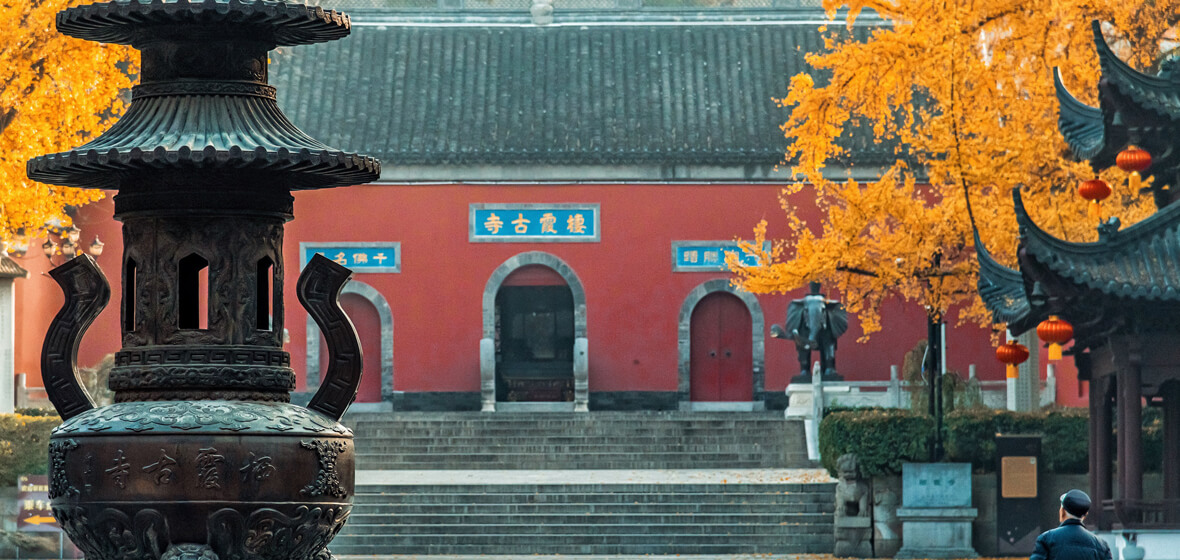
The word "capital" originates from the Latin word capitalis, meaning “of the head". In ancient China, the capital city is the largest city in the country and other cities were not permitted to exceed one-third of the capital city.
The ancient capital cities of China acted as the political, economic, and cultural center of the country, and needed to be protected, as well as to exert control and project unity.
As China boasts many ancient capitals of the world, it has its own unique story and spirit. With the ancient relics, history, culture, and with its blend of modernization, we want you to explore and uncover some of these cities' deep secrets.
Here is a list of the 10 ancient capitals in China for you to discover and put on your bucket list when planning your trip to China.
Top 10 Ancient Capitals of China
- Beijing (Former Names: Zhongdu, Dadu, Beiping)
- Xi'an (Former Names: Xianyang,Chang’an)
- Nanjing (Former Names: Jinling, Jianye, Jiankang, Jiangning, Yingtianfu)
- Zhengzhou (Former Names: Aodu, Bodu, Zheng)
- Kaifeng (Former Names: Daliang, Bian, Dongjing)
- Luoyang (Former Names: Luoyi, Luozhou)
- Anyang (Former Names:Yin, Yecheng )
- Hangzhou (Former Names: Yuhang, Qiantang, Xifu, Lin’an)
- Datong (Former Names: Yunzhong, Pingcheng)
- Chengdu(Former Names:Tianfu, Yizhou)
Beijing (Former Names: Zhongdu, Dadu, Beiping)
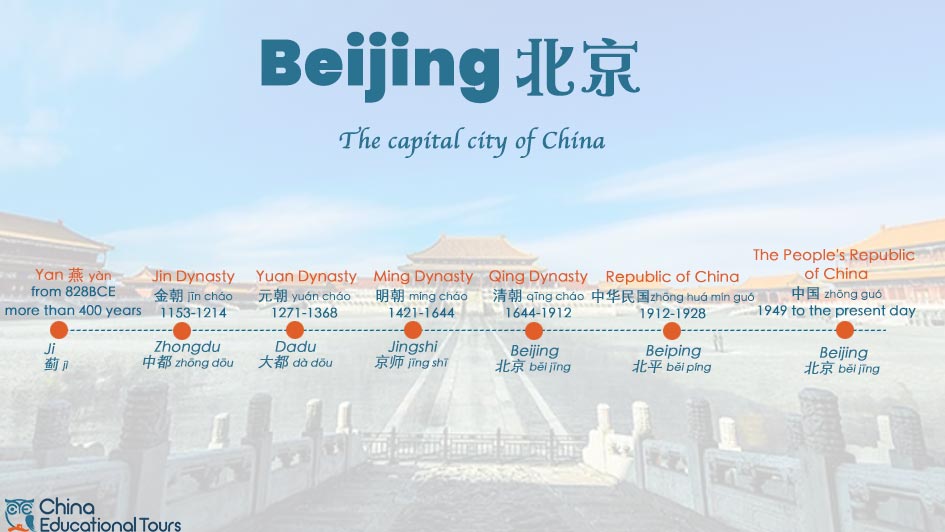
Beijing is the current capital city of China, which literally means “Northern Capital”, a reference to the city's location in the North of China. It was the capital of various dynasties and regional regimes such as:
- The Jin Dynasty from 1153 to 1214, for a total of 61 years. It was called Zhongdu.
- The Yuan Dynasty, Kublai Khan built a new city in the northeast of Beijing and named it Dadu (or Khanbaliq in Mongolian) in 1272 CE. You can still see the ruins of the northern city wall Dadu in the Yuan Dadu City Wall Ruins Park.
- The Ming Dynasty chose Beijing as the capital from 1421 to 1644. The original capital city of the Ming Dynasty is Yingtianfu (Nanjing). In 1421, Emperor Yongle moved the capital from Yingtianfu to Beiping, and changed its name to Beijing. In 1420, Emperor Yongle finished the construction of the Forbidden City which was used as the royal palace. In the same year, Emperor Yongle started to build the Temple of Heaven as the imperial sacrificial altar.
- The Qing Dynasty also use Beijing as its capital, from 1644 to 1911. The Qing Emperors restored old buildings of the Ming Dynasty and also built new buildings. In 1694, the Lama Temple was built and was formerly a prince's home, then a royal palace, and finally became a temple in the mid-18 century. In 1750, Emperor Qianlong built the Qingyiyuan (Summer Palace) for his mother.
Beijing was chosen as its capital from 1912 to 1928, a total of 16 years, and later moved to Nanjing. Due to the city's long history, UNESCO has listed seven of the city's most iconic structures as World Heritage Sites.
Recommended Beijing Tours
- One Day Tour of Beijing Essence
- 7-Day Tour to Learn Beijing’s Rich Cultures
- Hiking The Original Great Wall Sections In Beijing
- 4-Day Beijing Royal Highlights with Great Wall
- 5-day unique itinerary for family to explore Beijing
Xi'an (Former Names: Xianyang,Chang’an)
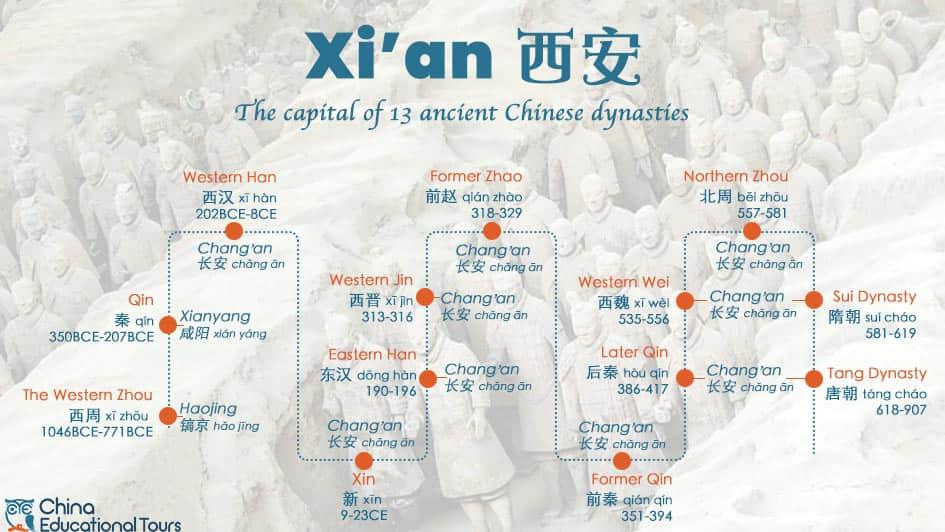
With 5000 years of history, Xi’an is one of the most ancient cities in China. As a world-famous ancient capital, Xi'an has been designated as the capital of 13 ancient Chinese dynasties such as the Western Zhou(1046BCE-771 BCE), Qin(221-206BCE), Western Han(202BCE-8CE), Xin(9-23CE), Eastern Han(190-196), Western Jin(313-316), Former Zhao(318-329), Former Qin(351-394), Later Qin(386-417), Western Wei(535-556), Northern Zhou(557-581), Sui (581-619)and Tang (618-907).
During the Qin Dynasty (221-206BCE), it was called Xianyang. There is still an area called Xianyang in the west of Xi’an. The airport of Xi’an is known as the Xianyang Intentional Airport. The famous Terracotta Warriors—discovered in the tomb of Qin Shi Huang, the First Emperor of the Qin Dynasty. Read more about The Terracotta Army.
Xi’an reached its prime during the Western Han (206 BCE- 8CE) and Tang (618-907) dynasties. It was known as Chang’an ("permanent peace").
During the Western Han dynasty, Xi’an became established as the starting point of the Silk Route, the ancient caravan trail that linked China with the European continent; this gave Xi'an enormous influence and wealth, making it an intersection of language, culture, and religion.
During the Tang Dynasty, Xi’an reached the height of its glory; it covered nearly 80 square kilometers (over 30 square miles). More than 1.5 million people called it home. Painting, literature, poetry, and music flourished, and the city was home to travelers from across Asia to the far East, who settled and built mosques and churches, making the city a center of Buddhist, Muslim, and Nestorian Christian culture.
To understand the grandeur of the great Tang dynasty, you can go to visit the Daming Palace Ruins of the Tang Dynasty in Xi’an.
Recommended Xi'an Tours
- Xi'an Private One Day Tour
- 3-Day Xi’an Terracotta Warriors Tour
- 5 Days Private Tour: trace back Xi’an’s history and culture
Nanjing (Former Names: Jinling, Jianye, Jiankang, Jiangning, Yingtianfu)
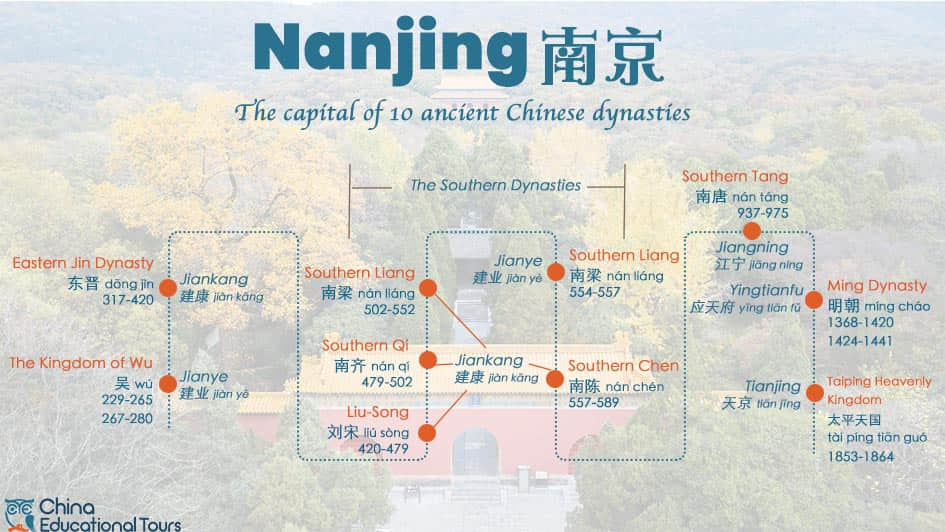
Since the 3rd century, Nanjing has been a cultural center attracting intellectuals from all over the country.
Sun Quan made it the capital of the Kingdom of Wu from 229 to 280. It was known as Jianye.
Eastern Jin Dynasty (317 - 420) made it the capital, andwas called Jiankang.
The Southern Dynasties (420-589) also made it the capital and was called Jiankang. The four Southern Dynasties were the Liu-Song (420–479), the Southern Qi (479–502), the Southern Liang (502–557), and the Southern Chen (557–589).
The Southern Tang (937-975) chose Nanjing as its capital and was called Jiangning.
In 1368 CE, Zhu Yuanzhang, or Hongwu Emperor, founder of the Ming Dynasty made Nanjing the capital of China and was called Yingtianfu. The emperor built a grand imperial palace and a city wall. You can visit the Xiaoling Mausoleum which is the tomb of the Hongwu emperor and his queen. The highlight of the mausoleum is the Sacred Way lined with pairs of stone-sculptured animals (such as elephants, lions, and camels) guarding the tomb. The city wall of the Ming Dynasty can still be seen today.
In 1405 CE. Zheng He began his first of seven great voyages from Xiaguan port in Nanjing. He led a large fleet of over 240 ships, with 27,800 sailors to the Pacific and Indian Oceans. His seven voyages went as far away as Africa and the Middle East. You can learn more about Zheng He when you visit the Zheng He Treasure Ship Park. This is where Zheng He built and launched his fleet that made 7 voyages around Asia and the Middle East. There is a replica vessel that will give you an image of the size of his fleet.
In 1421 CE, Emperor Yongle moved the capital to Beijing. Nanjing became the auxiliary capital city and it remained an important economic and political center. In 1928, the Republic of China moved the capital from Beijing to Nanjing. The Presidential Palace of Nanjing is a legacy of that period and offers rare insights into China's modern history.
1937 was the darkest year in Nanjing's history when the Japanese army brutally slaughtered over 300,000 people–including both soldiers and civilians. The Nanjing Massacre Memorial Hall was constructed on a massive grave of those who were killed.
Zhengzhou (Former Names: Aodu, Bodu, Zheng)
Zhengzhou is the capital and largest city of Henan Province in central China with a population of more than 10 million.
Zhengzhou was named the capital of the Shang Dynasty (16th century - 11th century BC) and was called Aodu and Bodu. The Shang-era capital city wall built 3,600 years ago can still be seen today. The Zhengzhou Shang Dynasty Capital Site Museum houses more than 1,000 relics including bronze ware, jade ware, bone ware, and pottery of Shang Dynasty. The Western Zhou (c. 1045 BC – 771 BC), was the capital city of a vassal state called Guan State. During the Warring States period (c.475BCE - 221 BCE), it was the capital city of the Han State.
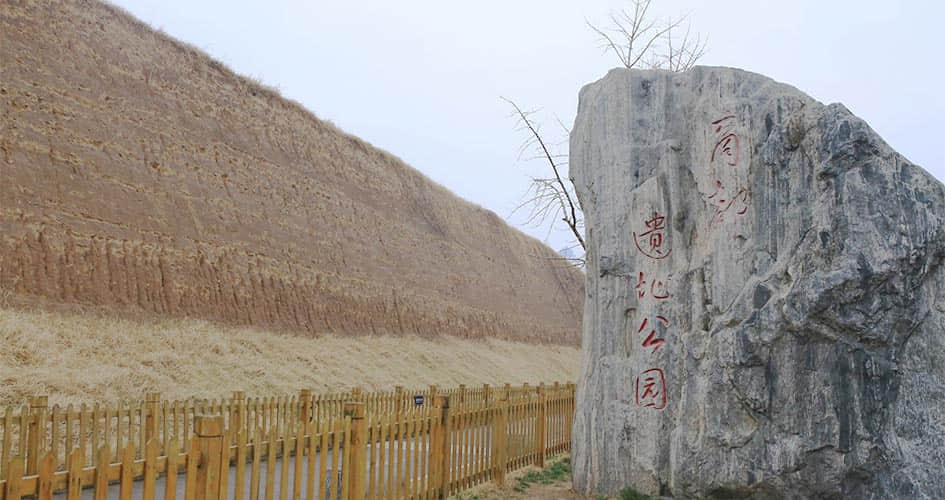
Ruins of the Shang Dynasty
Zhengzhou is rich in cultural heritage with many tourist attractions. Zhengzhou Confucius Temple, built during the Eastern Han dynasty 1900 years ago, is one of the oldest Confucian Temples in China. The Henan Museum in Zhengzhou is a fabulous resource that provides rich insights into more than 5,000 years of Chinese history. The world-famous Shaolin Temple is only 90 km from Zhengzhou.
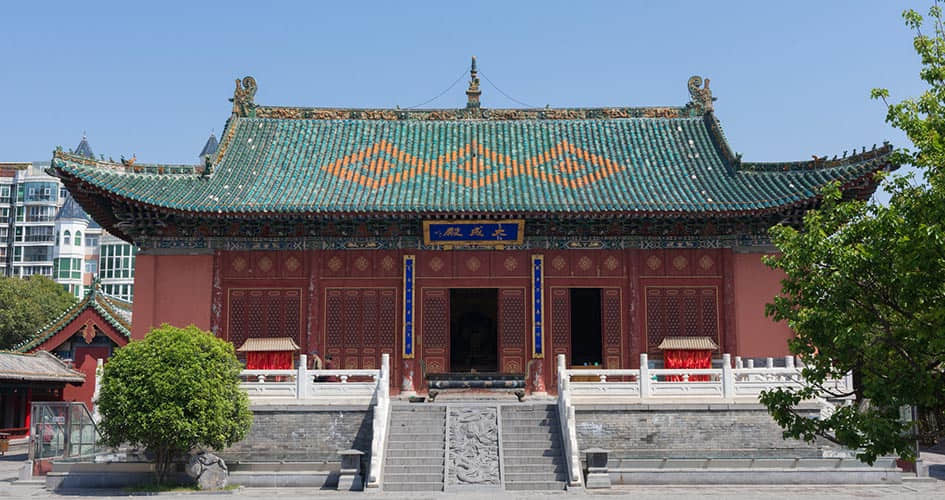
Zhengzhou Confucius Temple
Kaifeng (Former Names: Daliang, Bian, Dongjing)
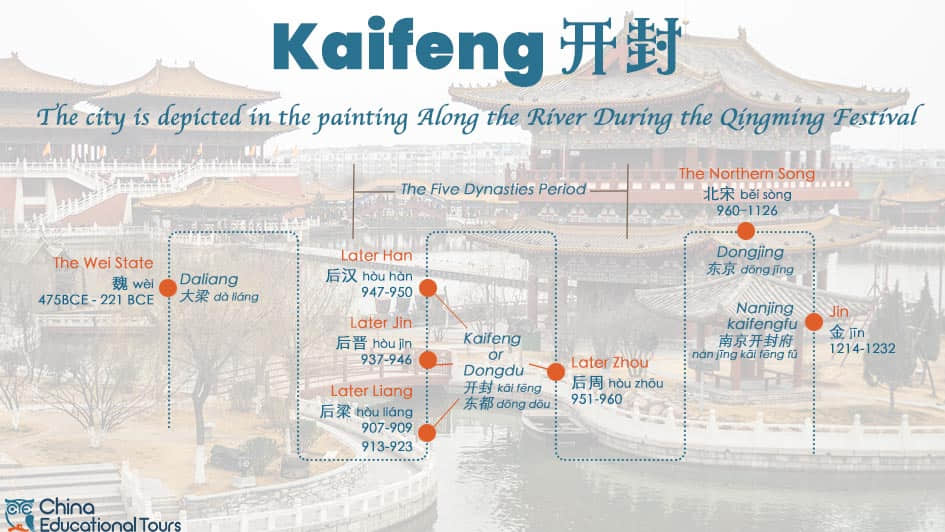
Kaifeng, located south of the Yellow River was flooded seven times in history and most of its history was buried under layers of mud.
During the Warring States period (c.475BCE - 221 BCE), it was the capital city of the Wei State; known as Daliang.
In 781 during Tang Dynasty, a new city was reconstructed in the city area of Kaifeng and named Bian. Bian was the capital of Later Jin (936-946), Later Han (947-950), and Later Zhou (951-960) of the Five Dynasties Period.
In 960, Later Zhou was replaced by the Northern Song Dynasty. In the Northern Song (960–1126), Kaifeng was called Dongjing which means eastern capital city.
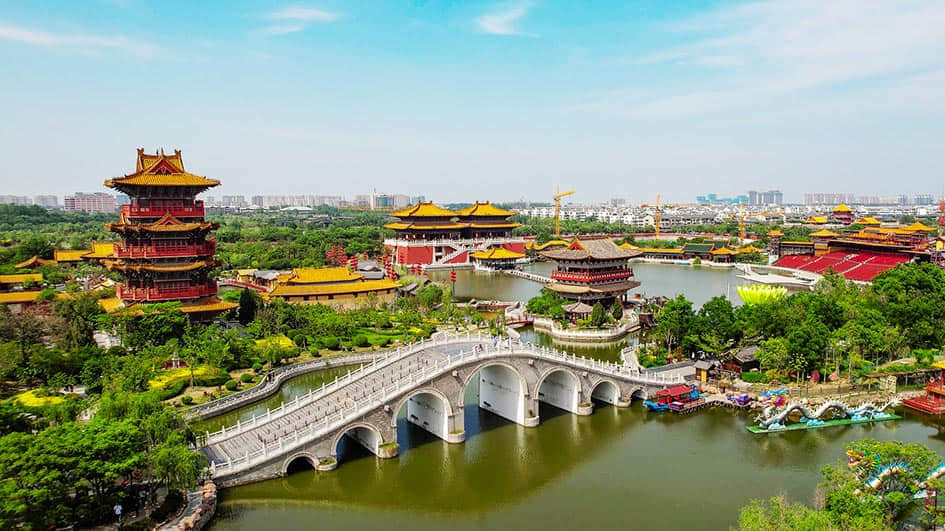
Kaifeng, the real location in the painting Qingming Festival by the Riverside
In this era China witnessed the flourishing of Buddhism, Taoism, and Confucianism; and saw the development of porcelain making and reproduction printing. Kaifeng reached its heyday during this period when more than 1.5 million people resided in Kaifeng. The city's landscape and people's lives back then were delicately captured in a famous painting named "Along the River during the Qingming Festival," or "Qingming Shanghe Tu" in Chinese. To capture the life of 1000 years ago, you can visit Millennium City Park, a large historical and cultural entertainment park representing the buildings and scenes of the paintings in real ratio. The Kaifeng Iron Pagoda is a Buddhist pagoda built in 1049 during the Song Dynasty and can be seen in the northeastern part of the city.
During the Northern Song Dynasty, many Jews came to live in Kaifeng and built a synagogue in the national capital to observe the customs of their ancestors and to hand down their doctrines to their descendants. See China Jewish Tour.
The last dynasty that chose Kaifeng as its capital city is Jin Dynasty (1115 - 1234). In 1214, the Jin Dynasty moved its capital city from Beijing to Kaifeng.
Luoyang (Former Names: Luoyi, Luozhou)
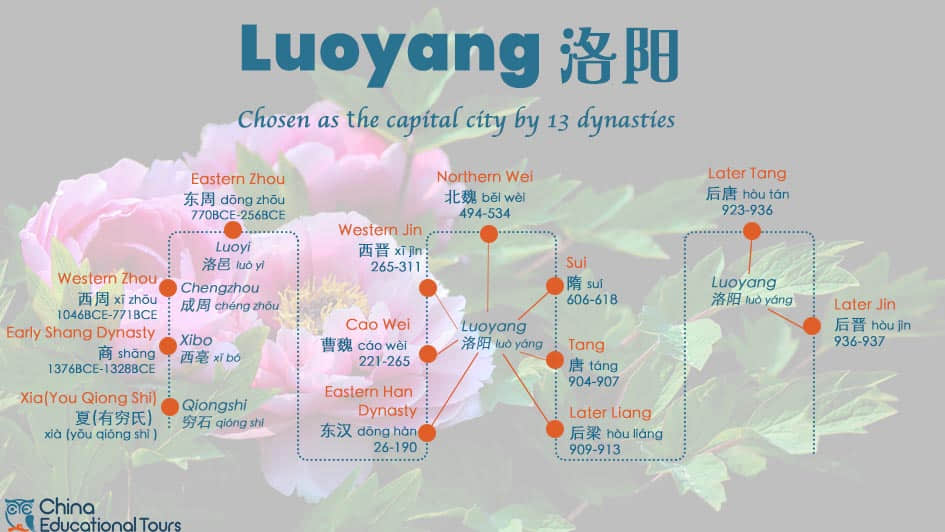
Luoyang got its name due to its location on the north bank of the ancient Luoshui (Luo River). Luoyang is one of the cradles of Chinese civilization and arguably the first city on the ancient Silk Road. About 20 km from Luoyang, you can find the Erlitou site, the capital of the first recorded dynasty in China, dating back from 1,900 BC to 1,500 BC.
The first Buddhist temple - the Baima Temple (“White Horse Temple”) was built in 68 CE in Luoyang. In ancient times, Luoyang was the transportation hub of road networks extending in all directions, therefore was chosen as the capital city by 13 dynasties. It included Xia, Shang, Western Zhou, Eastern Zhou, Eastern Han Dynasty, Cao Wei, Western Jin, Northern Wei, Sui, Tang, Later Liang, Later Tang, and Later Jin.
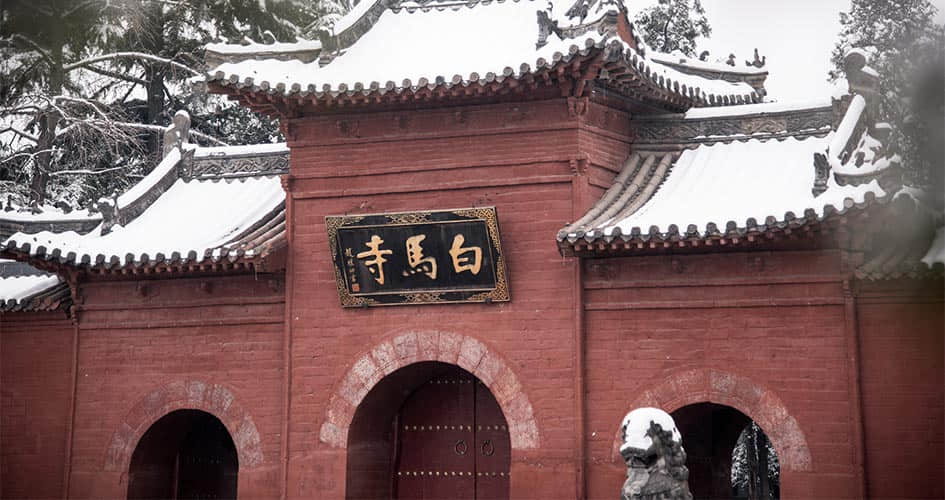
Luoyang White Horse Temple - The First Buddhist Temple
During the Eastern Han Dynasty (25-220CE), White Horse Temple, the oldest Buddhist Temple in China was built in 68 CE.
During the Northern Wei Dynasty (386-634), the emperor Xiaowen moved the capital city from Pingcheng (Datong) to Luoyang in 494. The construction of Longmen Grottoes, a Buddhist cave complex began construction in 493 CE and is now listed as a UNSECO heritage site.
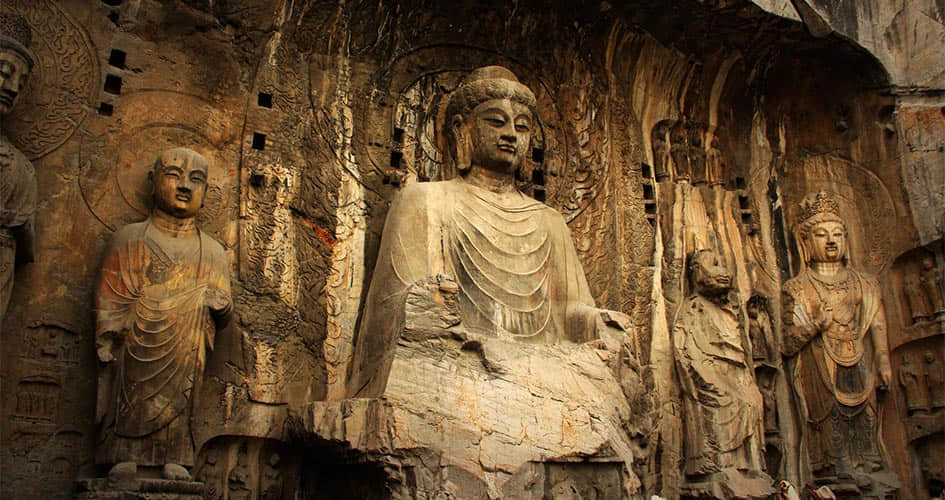
Read more about Longmen Grottoes
During the Tang Dynasty (618–907), Luoyang was the eastern capital of the empire; the western capital was Chang’an (Xi’an). China’s only female emperor – Empress Wu Zetian reigned from 690-705 CE and she lived in Luoyang for 22 years. During her political heyday, two of the grandest architectural wonders known as Tian Tang (Heavenly Hall) and Ming Tang (Hall of Enlightenment) were built as symbols of splendor and opulence. The former was intended for meetings with government officials, while the latter was designated for religious ceremonies. Unfortunately, both iconic towers were destroyed by fire in 695 CE. To capture the magnitude of Luoyang, a visit to Sui and Tang Luoyang City National Heritage Park was partially rebuilt on the ruins of the original site. When you visit the attraction at night, the lights display are an impressive re-enactment of the glory of its past days. This attraction is a must-see during your visit to Luoyang if you want to understand the Tang heritage of the city.
Recommended China Tours including Luoyang City
Anyang (Former Names: Yin, Yecheng )
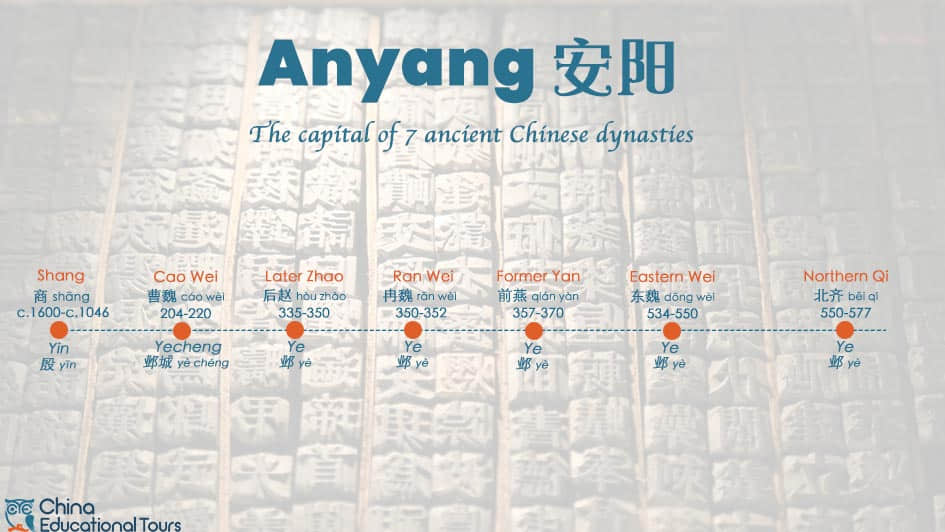
Anyang, in Henan Province in northern China, is a famous ancient city with a history of more than 3,300 years. Seven dynasties chose Anyang as their capital: Shang (c.1600-c.1046), Cao Wei(220-266), Later Zhao (335-350), Ran Wei (350-352), Former Yan (357-370), Eastern Wei (534-550) and Northern Qi (550-577).
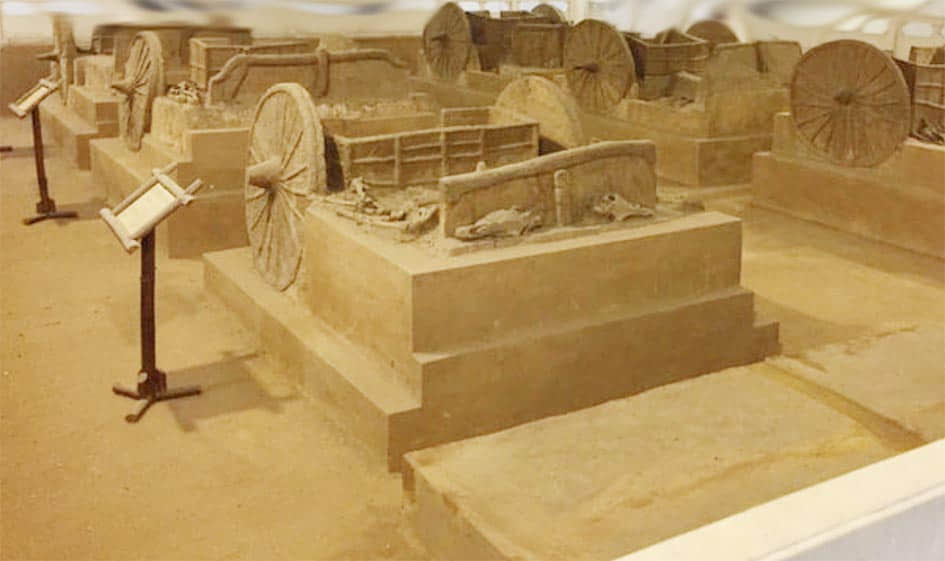
Yin Xu Chariot Pits
Anyang is best known as the capital city of the Shang Dynasty. In 1899, hundreds of oracle bones were found in Anyang. Full-scale excavations began in 1928, and since then, investigations by Chinese archaeologists have revealed nearly 25 square kilometers (about 10 square miles) of the enormous capital city. Yin Xu or the ‘ruins of Yin’ is an archaeological site containing the remains of Yin. Yin Xu has been recognized as one of the most important archaeological sites in China and was listed as a UNESCO World Heritage Site in 2006.
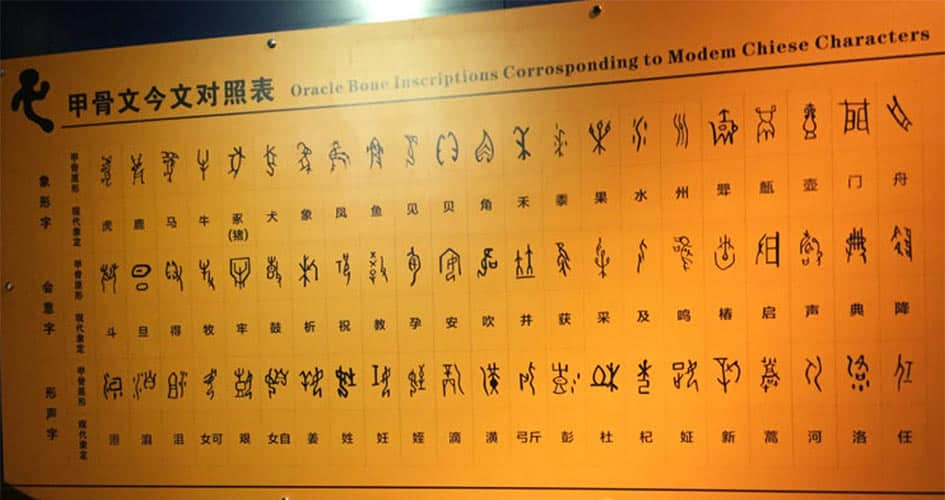
Oracle Bone Inscriptions Corresponding to Modem Chinese Characters
This script oracle bones is the earliest known writing in China and is the root of modern Chinese writing. The National Museum of Language was constructed in Anyang to preserve those legacies.
Hangzhou (Former Names: Yuhang, Qiantang, Xifu, Lin’an)
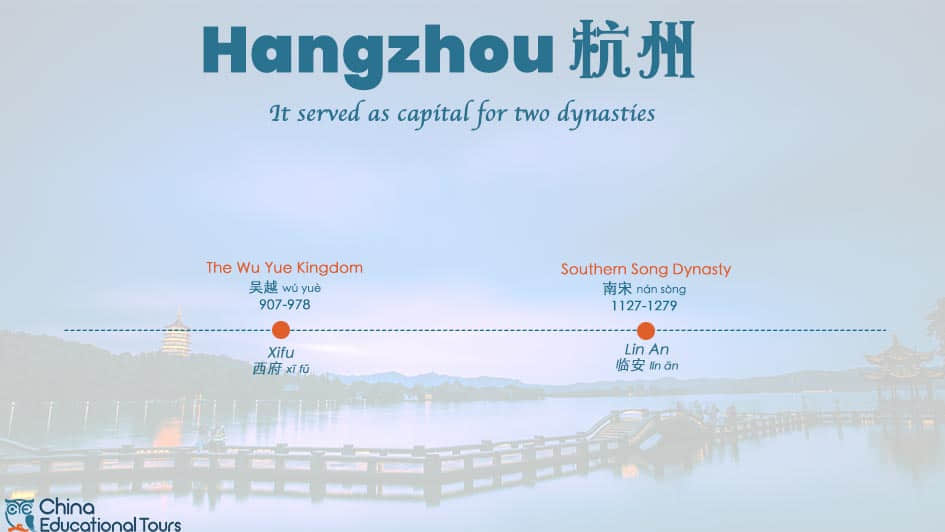
Today Hangzhou is one of China’s leading e-commerce centers – one that has played a seminal role in digital development and was once an ancient city with a rich and complex history. It served as capital for two dynasties. The first was during the Wu Yue Kingdom from 907 to 978 and was known as Xifu. The second was during the Southern Song Dynasty (1127-1279) and was called Lin’an. As an important hub and port along the Grand Canal, trade activities in Hangzhou were especially prosperous during the Southern Song Dynasty. It became a distribution centre for many types of wares, with merchants from Fujian and Guangdong importing exotic goods to the city including spices from South East Asia. There were more than 1.2 million people that lived in the urban area of Hangzhou. Marco Polo visited Hangzhou in late 13th century; he described Hangzhou as the finest and most splendid city in the world.
Recommended Hangzhou Tours
- Half Day Tour of Grand Canal World Culture Heritage
- Half Day Tour of Southern Song Dynasty Culture
- 2-Day Hangzhou City and Tea Culture Tour
- Hangzhou Educational Tour
Datong (Former Names: Yunzhong, Pingcheng)
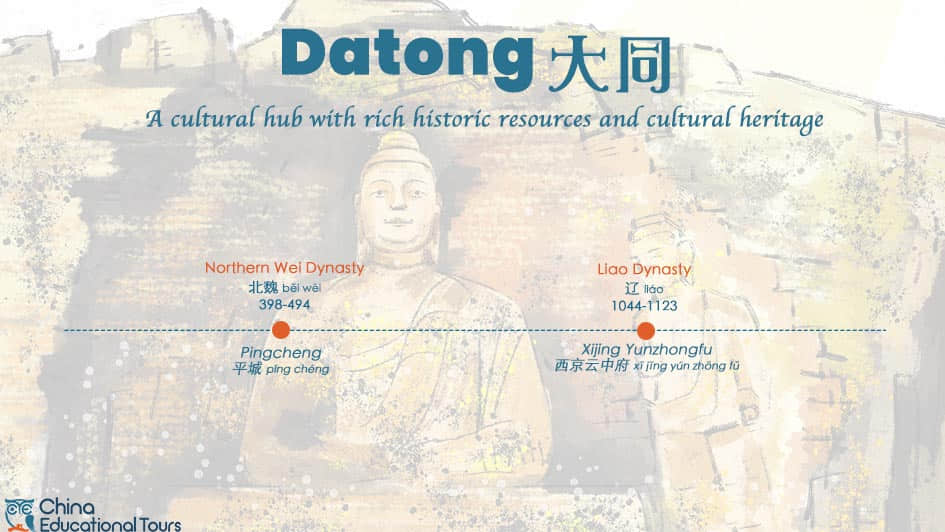
Datong, an ancient city in Shanxi Province is located at the juncture of the farming civilization of the Central Plains and the nomadic civilization of the north. As the capital during the Northern Wei Dynasty (386-534), Datong city has remained a cultural hub with rich historic resources and cultural heritage for centuries afterward.
Datong was the capital of the Northern Wei Dynasty (386-534 CE) from 398 to 494 and was known as Pingcheng. Buddhism was adopted as the state religion around 450CE and the Northern Wei rulers were great patrons of Buddhism. The main parts of Yungang Grottoes were constructed from 460 to 494. The Yungang Grottoes include 51,000 sculptures that range in size from barely two centimeters to over 17 meters high. It was listed as UNESCO World Heritage site.
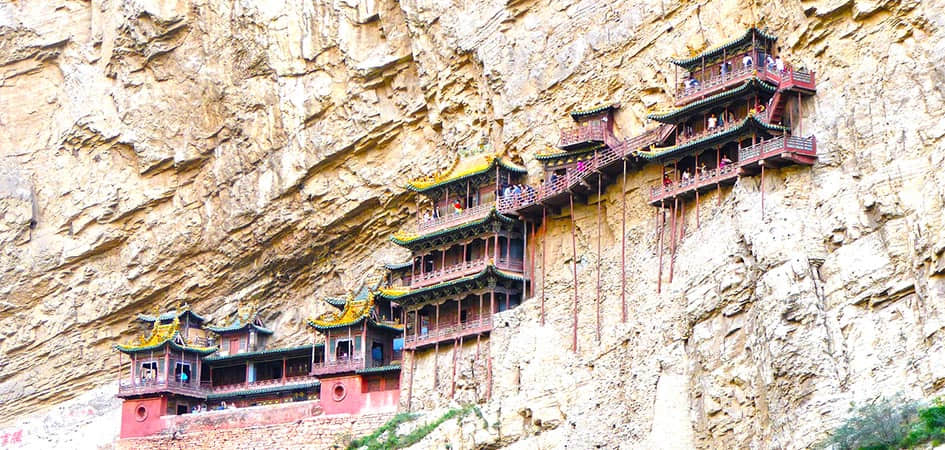
Hanging Monastery or Xuankong Temple is a temple built into a cliff near Mount Heng in Hunyuan County
Another important cultural site was built during the Northern Wei period is the Hanging Monastery, which was constructed in 491.
A second period of greatness came with the arrival of the Mongol Liao Dynasty (907-1125), also Buddhists, who made Datong one of their five capitals in 907. Liao Dynasty was defeated and replaced by Jin in 1125, again Datong was chosen as one of its 6 capitals. Today, the legacy Liao and Jin period are still evident, notably in the central Huayan temple, Shanhua Temple and Yingxian Wooden Pagoda (oldest wooden multi-storey structure of the world) in the nearby town of Yingxian.
Recommended Datong Tours
Chengdu (Former Names:Tianfu, Yizhou)
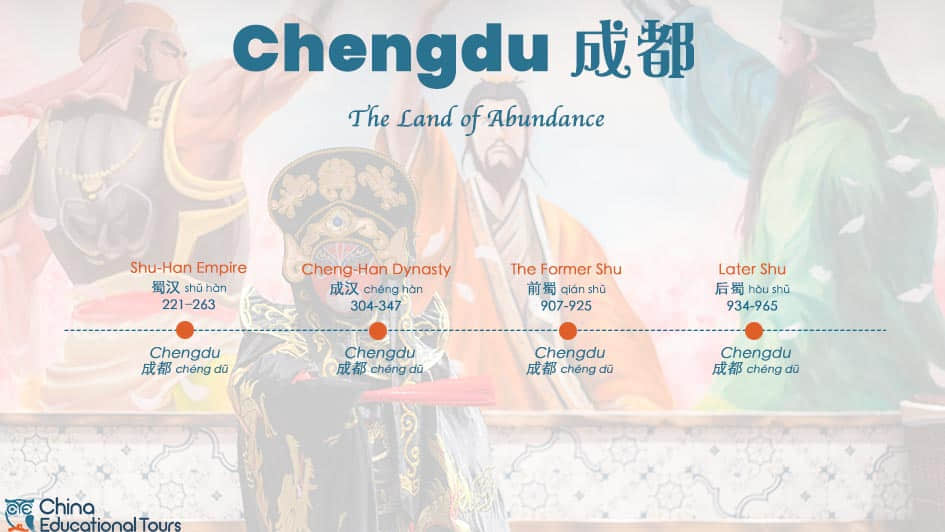
Chengdu is the capital of China’s southwestern Sichuan province and is famously known as the home to the giant pandas. It was also announced as a UNESCO City of Gastronomy for its well-known history as a food cultural hub.
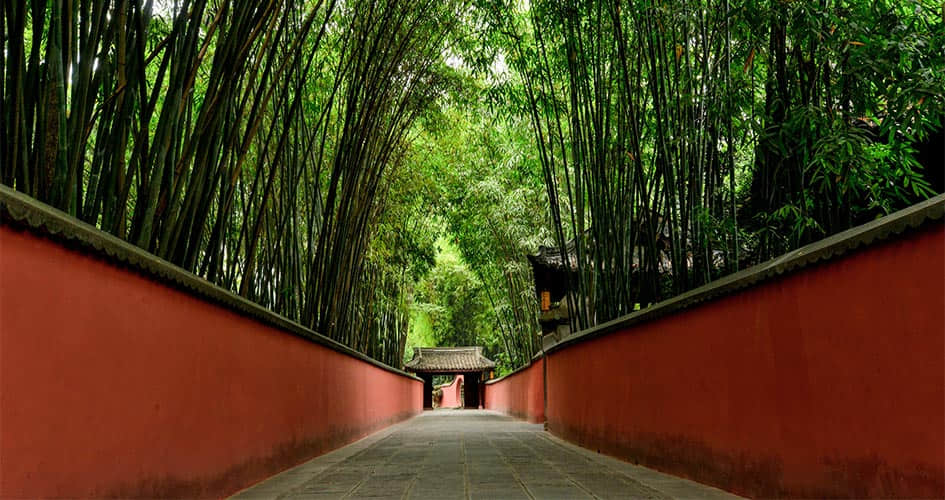
Du Fu Cottage Home of the famous Chinese poet Du Fu
The fertile Chengdu Plain, on which Chengdu is located, is also known as "天府之国 Tiān fǔ zhi guó", a phrase often translated as “The Land of Abundance”. The discovery of the Jinsha site suggests the area of Chengdu had become the center of the Bronze Age Sanxingdui culture around the time of the establishment of the State of Shu, before its annexation by Qin in 316 BC. Historically, it was the capital city of the Shu-Han Empire (221–263), Cheng-Han Dynasty (304-347), the Former Shu (907-925), and Later Shu (934-965). Due to Sichuan's location as a basin surrounded by mountains and the presence of the Yangtze River, the area also became a sanctuary throughout much of China's history. Two Emperors in the Tang Dynasty fled to Sichuan during the rebellion. The famous Tang Dynasty poem Du Fu also spent 4 years in Chengdu, and you can still visit his cottage today.

Chengdu: the home to the giant pandas
Not only can you enjoy seeing the giant pandas and Sichuan cuisines, but spending time in a teahouse in Chengdu is a gem where you can relax and learn about Chinese tea culture and learn about local life from days gone.
Recommended Chengdu Tours
- 1-Day Panda Keeper Tour in Dujiangyan Base
- Chengdu Educational Tour
- Family Tour In Chengdu
- Pandas And Fairyland Of Jiuzhaigou Valley

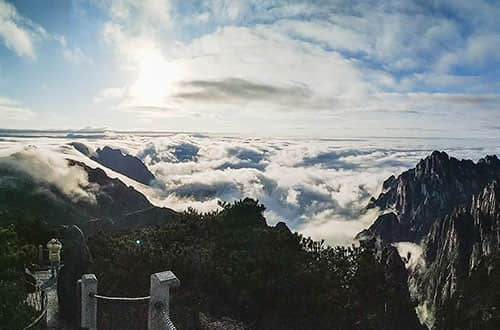 Which is the Best Month to Visit China?
Which is the Best Month to Visit China?  Top 10 Most Beautiful Places in China
Top 10 Most Beautiful Places in China 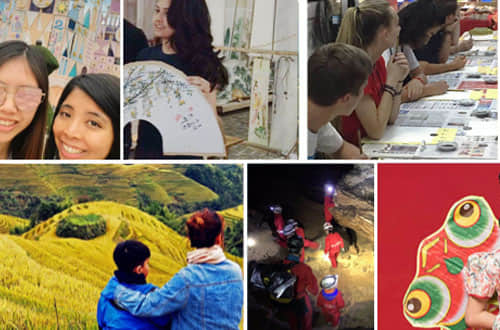 Top Family Vacation Destinations
Top Family Vacation Destinations 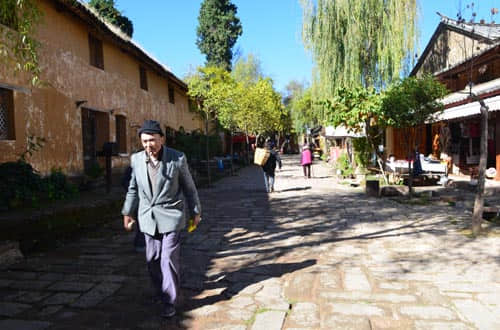 Top 10 Old Towns
Top 10 Old Towns